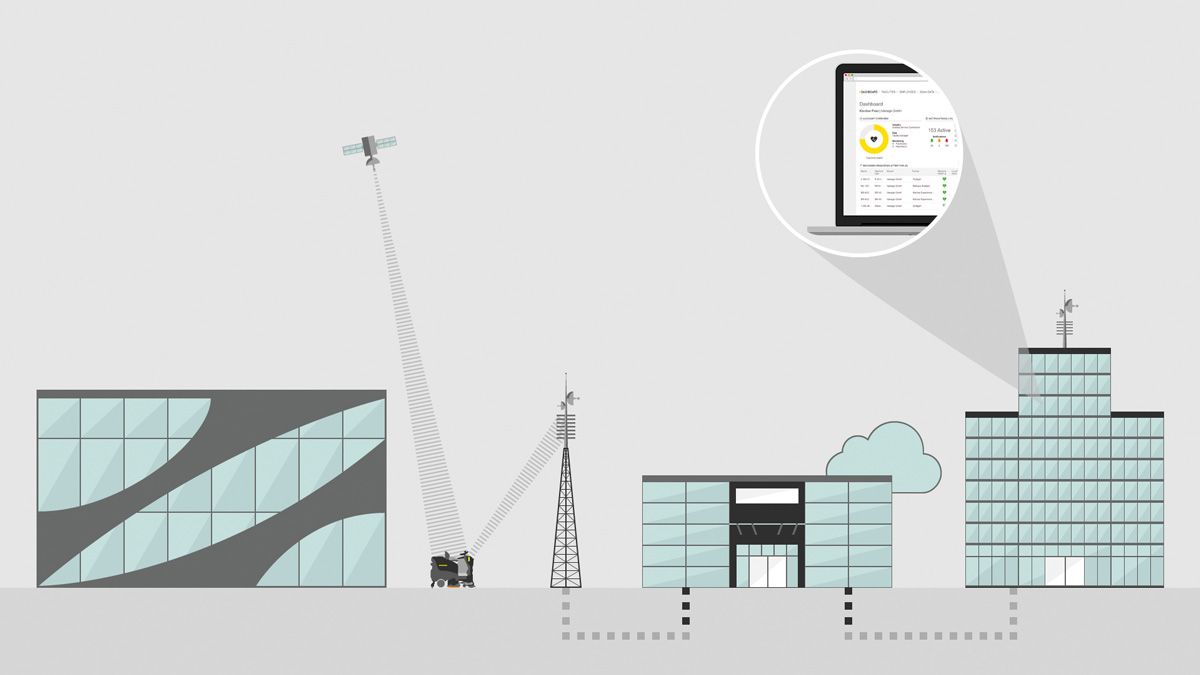Kärcher
FLEET MANAGEMENT ON AWS CLOUD
INDUSTRY
Manufacturing
CLOUD PROVIDER
Amazon Web Services

Kärcher is the world's leading supplier of cleaning technology. One of the services offered is Kärcher Fleet, a fleet management solution that provides up-to-date data transmitted by the cleaning equipment. Authorized users – usually facility managers who manage the professional cleaning fleet – can access the web-based solution via PCs, notebooks, or mobile devices to obtain device-relevant data such as battery status, location, or utilization. Kärcher Fleet is one of the first steps in the strategic positioning of the company to create added value. By making devices smarter, the company wants to help customers optimize the efficiency of their cleaning fleet.
This is a paragraph. Writing in paragraphs lets visitors find what they are looking for quickly and easily.
This is a paragraph. Writing in paragraphs lets visitors find what they are looking for quickly and easily.
This is a paragraph. Writing in paragraphs lets visitors find what they are looking for quickly and easily.
This is a paragraph. Writing in paragraphs lets visitors find what they are looking for quickly and easily.
CLOUD BENEFITS
Simple, flexible, economical, reliable, scalable, and secure
REAL-TIME DATA
More control through real-time tracking and monitoring of assets globally
CONTINUOUS IMPROVEMENT
Usage and wear data helps with continuous improvement of devices
Our strategy is now called “cloud first”. AWS will be our first choice for digital initiatives, no matter what path we choose for our various businesses.
PROFESSOR DR. MATTHIAS MEHRTENS
Vice President Information Systems at Kärcher
MAKING PRODUCTS MORE EFFICIENT AND ECONOMICAL
Since its founding in 1935, innovation has always been a key element of the company's corporate culture. Year after year, Kärcher invests large sums in research and development. In addition, more than 900 engineers and technicians worldwide work on the development of new products. In the time of the Internet of Things (IoT), the cleaning technology provider was constantly striving to make products more efficient and economical in order to improve the customer experience. As the company was convinced of the idea of connecting devices to the Internet, Kärcher Fleet was introduced.
Kärcher excluded running the solution in its internal data center because it knew it needed faster time to market and a more agile, on-demand scalable IT infrastructure. “Since we are in a competitive market, we need to act quickly and therefore need partners with whom we can quickly implement our web-based solutions in dozens of countries around the world. Our focus is designed for the long term,” says Professor Dr. Matthias Mehrtens, Vice President Information Systems at Kärcher.
AWS AS CLOUD FIRST CHOICE
Kärcher first worked with Amazon Web Services (AWS) in 2012 to provide a platform for the delivery of user manuals and to relaunch the global website. These projects were successful with the support of today's AWS Partner Network (APN) Premier Consulting Partner Zoi, which specializes in consulting and implementing individual cloud solutions: faster content delivery and improved customer experiences thanks to lower latency.
As the company was impressed by the benefits of the cloud, it decided to operate Kärcher Fleet using AWS in 2013. “This was our first IoT use case. However, based on our experience with AWS, we knew that they could provide us with the flexible platform we needed to bring our solution to market,” says Professor Mehrtens.
Each Kärcher device is equipped with a Vodafone SIM card that sends data directly to the AWS environment via the Vodafone network. This data is processed by Amazon Elastic Compute Cloud (Amazon EC2) instances running on Windows servers. With Auto Scaling, capacity is automatically ramped up or down, Elastic Load Balancing distributes traffic, and Amazon Simple Storage Service (Amazon S3) provides fully redundant storage.
Kärcher's database is based on Amazon Relational Database Service (Amazon RDS) with Microsoft SQL Server. “This is where we store all the information about Kärcher products,” explains Oliver Dembniak, Head of the New Technology department at Kärcher. “Since we receive information every few minutes, we generate a lot of data.”
Amazon Route 53 provides the Domain Name System services, while Amazon Simple Email Service (Amazon SES) is used for email administration. Content is distributed with low latency to the worldwide subsidiaries via Amazon CloudFront.
Using Amazon Identity and Access Management (IAM), Kärcher employees working with the AWS Console can control access to AWS resources, and the AWS Support Business provides the company with “fast and helpful support”, according to Oliver Dembniak.
COMPLETE OVERVIEW OF MACHINES, PERSONNEL & ACTIVITIES
To be successful in the cleaning products market, continuous innovation is a must. “The AWS model makes it easy for us to generate new technologies,” Professor Mehrtens emphasizes. “AWS is constantly bringing out new features and services and by using AWS' cloud services, we can do exactly that with our portfolio.”
Professor Mehrtens sums up why cloud services are at the heart of new initiatives at Kärcher: “For us, the Internet of Things is a key differentiator in the market. Our engineers and technicians are constantly striving to develop products for the digital world. Connecting devices and giving customers access to an immense wealth of information to control their cleaning equipment creates added value – a decisive criterion for remaining at the forefront of the competition tomorrow. A perfect example of this is Kärcher Fleet – a project made possible by AWS.”
Before the fleet management solution was launched, the company did not know how well the solution would be received and what fluctuations in demand would occur at the various locations. Professor Mehrtens: “If customers in Asia, for example, were to accept the solution very well, we would have to scale it up quickly there, and with AWS we have the certainty that the capacity can be scaled up as required.” Kärcher also considers the AWS model to be cost-efficient, as no unnecessary computing resources are provided in areas of lower demand. “Thanks to the global presence of AWS, we have worldwide access to flexible IT,” adds Professor Mehrtens. “We can actively monitor instances and scale them up or down as needed, and thus benefit from a high level of control that would not be possible with traditional hardware.”
Since the resources are cloud-based, Kärcher is confident that high availability will also be achieved. Oliver Dembniak: “With our AWS infrastructure there are no major incidents, it runs without any complaints.”
Moving new projects forward quickly and offering resources in line with demand are basic prerequisites for ensuring that Kärcher's products and services are always competitive – Kärcher achieves this much faster and easier with AWS. “In the past, it used to take us months to provide new services with our own infrastructure,” confirms Professor Mehrtens. “Let's take a project implementation in Asia as an example: In order to carry out the work on-site, we sometimes needed more than three months and also had to travel to Asia. By working with AWS, we only need a few days, even for large projects with several servers.”
The Kärcher team intends to make greater use of AWS in the future to better integrate devices with IoT and to operate additional internal systems, including mission-critical applications. Professor Mehrtens sums up: “Our strategy is now called “cloud first”. AWS will be our first choice for digital initiatives, no matter what path we choose for the different business units.”
ABOUT KÄRCHER
Alfred Kärcher SE & Co. KG is headquartered in Winnenden, Germany, and has 150 subsidiaries in 78 countries. They are the world's leading supplier of cleaning technology and are probably best known for their high-pressure cleaners and range of products and services for professional cleaning of offices, hotels, and supermarkets. The family-owned company employs around 14,400 people and can look back on a company history spanning more than 85 years.
With Kärcher Fleet, the service technicians are only contacted when the machines require maintenance so that they receive valuable information to service the machine correctly the first time. Source: Kärcher

CAROUSEL FILTER SETUP
CASES
Here are a few examples of how we have successfully supported our Manufacturing customers.
This is a paragraph. Writing in paragraphs lets visitors find what they are looking for quickly and easily.
This is a paragraph. Writing in paragraphs lets visitors find what they are looking for quickly and easily.
This is a paragraph. Writing in paragraphs lets visitors find what they are looking for quickly and easily.
This is a paragraph. Writing in paragraphs lets visitors find what they are looking for quickly and easily.
LET’S EXCHANGE IDEAS
Because you could change direction much faster than you think.



